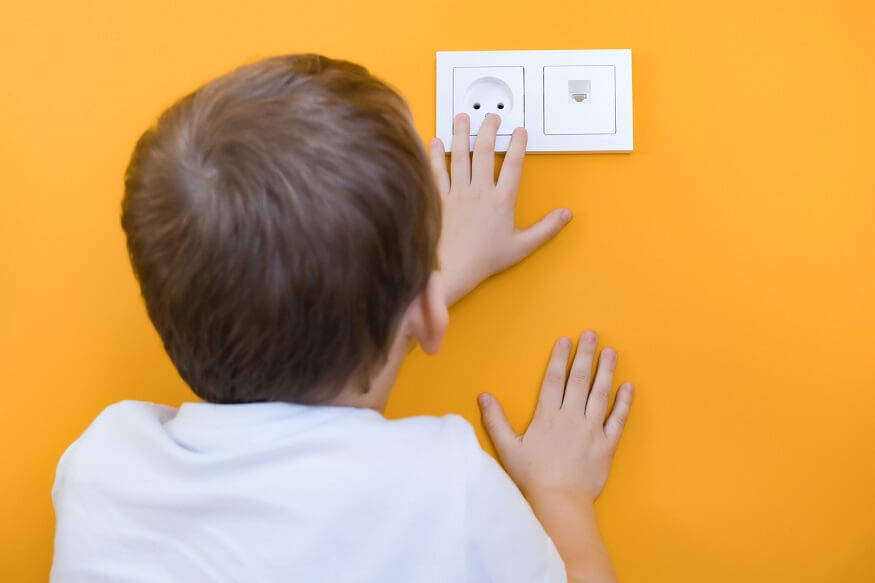Electricity along with electrical devices and appliances have become such an essential part of our lives that we often forget how dangerous it can be.
As adults, we utilise these devices with the knowledge and understanding of their potential danger. However, children, with their natural curiosity and innocence, might not comprehend the hazards that come with electricity use. Thus, it is imperative to educate them on electrical safety, particularly the dangers of sockets and appliances, to prevent any unfortunate accidents. In this blog, we will explore some of the best practices for electricity safety for kids.
Also Read: Fire Safety Tips for Kids
The Dangers of Sockets
Wall sockets, for children, might appear as interesting holes to poke or prod. However, this simple act can expose them to the risk of electric shock. Children, particularly those aged up to 4 years, are at the highest risk of electrical injuries, accounting for roughly 60% of all electrical-related incidents. These usually occur when children insert objects into sockets or when they come into contact with exposed live parts.
Given the high voltage flowing through domestic electrical sockets, usually between 110 and 220 volts, direct contact can lead to grave and immediate danger. Acute electrical burns can potentially lead to cardiac arrest and neurological damage.
Electrical incidents often trigger fire outbreaks, putting not just the victims at risk, but jeopardising the safety of entire households. Around 15% of all house fires are instigated by faulty electrical systems, with children’s tampering playing a significant role.
However, we can minimise these risks through various precautionary measures. Socket safety covers can prevent children from inserting objects, while supervision is crucial, especially for younger children. Educating them on the potential dangers is also essential as they grow older, instilling a sense of caution about electricity.
Prevention is key when handling these dangers.
Also Read: Water Safety Tips for Kids
The Dangers of Appliances
Household appliances like TVs, refrigerators, microwaves, toasters, and irons pose potential hazards for children if not used properly or left unattended. For instance, appliances with frayed or damaged cords can lead to electric shocks if touched or mishandled. One of the prominent dangers is burns and scalds.
In the kitchen, hot fluids or meals simmering on stove tops or in microwaves can inadvertently be accessed by a curious child, leading to severe burns. Additionally, appliances left plugged in near water sources or damp areas increase the risk of electric shock.
Young children, in their exploratory nature, may crawl inside washing machines, dishwashers, and refrigerators, potentially leading to suffocation. There is also a risk of heavy appliances like refrigerators or televisions tipping over, potentially causing fatal crush injuries.
Electric shocks pose another significant danger. Children, with their inherent curiosity, might insert objects into electric appliance outlets, resulting in electrocution Appliances with poorly insulated wiring or defective parts can endanger children through unintentional electric shocks.
Safety tips for kids
1) Do not climb trees near power lines
2) Do not plug a bunch of appliances or gadgets into one outlet or extension cord
3) Do not play near or on a green transformer box or climb the fence around an electrical substation.
4) Do not pull an electrical cord from the wall. Instead, pull from the plug
5) Stay away from broken or fallen power lines
6) Do not climb on power poles
7) Always ask an adult for help when you need to use something that uses electricity.
8) Never touch electrical sockets or switches with wet hands.
9) Avoid using electrical devices near water
Childproofing your home
1) Cover electrical sockets
2) Cover loose hanging cords using cord-hiding strategies
3) Store kitchen and bathroom appliances out of reach for children
4) Use plastic plug-in outlet covers for open outlets and sockets
5) Wrap up charger cords safely and place them somewhere out of reach
6) Keep power tools and electric lawn tools away
7) Educate children to never touch electric cords or switches when they are standing in water or have wet hands
8) Avoid keeping electronic items (such as a mobile phone) plugged in and switched on while you are away.
9) Install safety switches which cut the power immediately in an emergency.
10) Check your home’s wiring regularly for potential hazards, such as loose connections, damaged wires, or outdated components and get the necessary repairs done.
Also Read: Bicycle Safety Tips for Kids
Teach electrical safety
Teaching kids about electrical safety can help keep them safe from accidents. Below are some ways in which parents and caregivers can teach electrical safety to children:
1) Communication is Key: Start with simple, easy-to-understand language. Explain that electricity is like fire – it can be useful but also harmful if not used safely. Avoid using overly technical terms to avoid confusion.
2) Show and Tell: Walk them around your home and identify potential hazards such as sockets, appliances, and wires. Explain how to safely utilise these electrical items and the importance of not touching or playing with them without adult supervision.
3) Use Resources: Many educational materials, like child-friendly books or online videos, can explain electrical safety in engaging ways. Look for resources that suit your child’s age and understanding.
4) Lead by Example: Kids often imitate adults, so demonstrate safe electrical behaviours. Unplug appliances after use, avoid using devices near water, and see that all electrical cords are properly insulated and out of reach.
5) Implement Safety Measures: Use devices like socket covers and circuit breakers that automatically shut off power when there is a surge, keeping your home safer.
6) Rules and Reminders: Set guidelines about not inserting items into sockets or touching appliances with wet hands. Regularly remind them of these rules and the reasons behind them.
7) Emergency Lessons: Make sure your child knows what to do in case of an electrical accident. This includes not touching a person who is being electrocuted, but immediately alerting a grown-up and calling Emergency Services.
Also Read: Toy Safety for Kids
Equipping children with knowledge about electrical safety and the potential hazards of sockets and appliances can reduce the risk of accidents. It is everyone’s responsibility to ensure a safe environment for kids and encourage their growth without the lurking danger of electricity misuse. After all, safety does not happen by accident; instead, it is a result of careful planning, education, and precaution.










